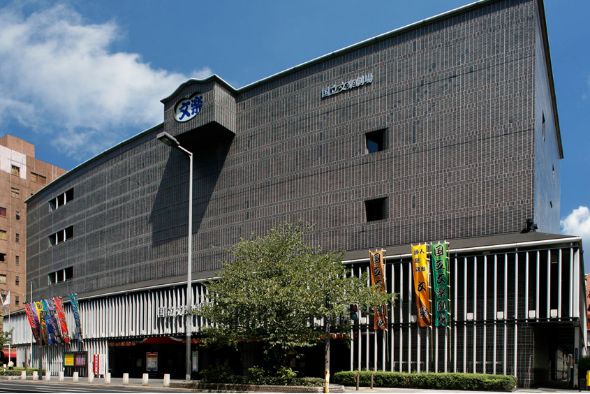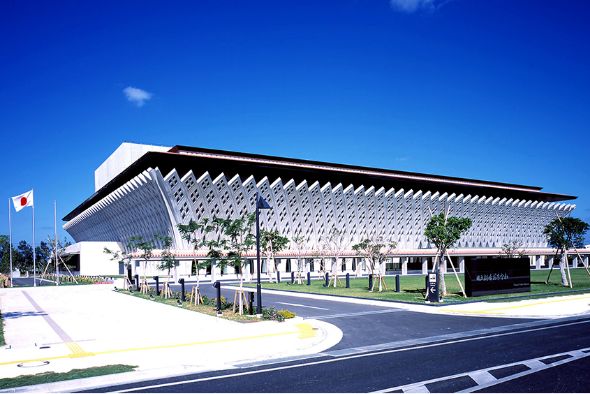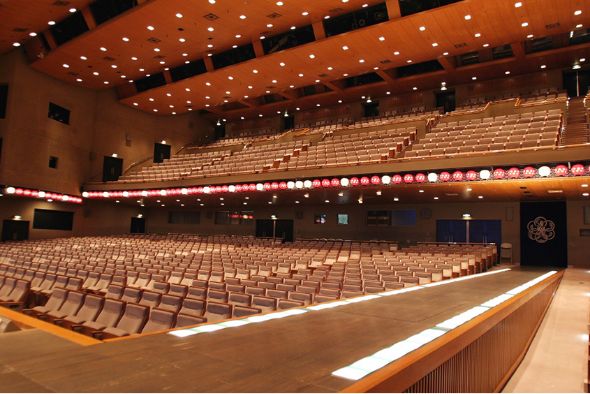Five traditional Japanese performing arts registered as UNESCO Intangible Cultural Heritage!
Traditional performing arts strongly reflect the history and culture of Japan. The performing arts of nohgaku, bunraku, kumiodori, kabuki, and gagaku each have its own era, background, and distinct characteristics, having shaped the spirit, sensibilities, and aesthetic senses of the Japanese people. Their diverse expressions and deep narratives have fascinated audiences from both Japan and abroad. These performing arts can be viewed at dedicated facilities throughout Japan, or experienced firsthand to get a feel of their true essence. Embark on a journey to experience the depth of the traditional performing arts that Japan has to offer.
Nohgaku

Nohgaku, one of Japan's world-renowned traditional performing arts, is the collective name for noh and kyogen, both of which are performed on a noh stage. Noh is a song-and-dance drama in which performers in beautiful costumes and masks weave a story using spoken dialogue and dance accompanied by instrumental and vocal music, while kyogen is a dialogue-focused drama centered on themes such as the daily lives of ordinary people and satire. These have a long history of more than 600 years and have influenced bunraku, kabuki, and even opera and modern theater. The National Noh Theatre was established in Shibuya, Tokyo, in 1983 to carry on this tradition and to promote the appeal of nohgaku. The theater shares the appeal of nohgaku—which is recognized as a UNESCO Intangible World Cultural Heritage—to a wide range of people from Japan and abroad through regular and special performances, historical exhibitions, and nohgaku viewing classes for international visitors.
For a more in-depth look at the world of noh theater, visit the following website and attend a performance for yourself.
https://www2.ntj.jac.go.jp/unesco/noh/en/

National Noh Theatre
- Place
- 24-18-1 Sendagaya, Shibuya-ku, Tokyo 151-0051, Japan
Bunraku

Bunraku, one of Japan's major traditional performing arts, was created by combining joruri—a style of storytelling that accompanies verses—with the use of the shamisen and puppetry. That is why it was originally called "ningyo joruri" (puppet joruri). While serious narratives of the impermanence of things, human karma, tragic love, and separation of parents and children are presented, witty humor and flamboyant dance are also signifcant elements of the performance. It is a comprehensive art form created by a trinity of performers: the tayu, who alone narrates both scenes and lines; the shamisen player, who adds color to the story with music; and the three puppeteers, who visually express the story through the manipulation of a single puppet. The National Bunraku Theatre in Osaka conveys the appeal of bunraku through performances and various exhibitions. A commentary book with an English synopsis and audio guide (for some performances) are also available, so that even foreigners unfamiliar with bunraku can fully enjoy the appeal of this art.
Visit the theater to experience the intricate art of bunraku, where multiple elements are beautifully intertwined.
https://www2.ntj.jac.go.jp/unesco/bunraku/en/

National Bunraku Theatre
- Place
- 1-12-10 Nippon-bashi, Chuo-ku, Osaka-shi, Osaka 542-0073, Japan
Kumiodori

Kumiodori is a song-and-dance drama consisting of dialogue, music, and dance. Its origin dates back to the early 18th century, when Okinawa was governed by the Ryukyu Kingdom. It is said to have originated when Tamagusuku Chokun, who was in charge of entertaining envoys from China at the time, created it by putting together the best of traditional Okinawan culture—including the old Okinawan language, Ryukyu music, and Ryukyu dance—while using noh, kyogen, and kabuki as references. The classics have continued to be performed for more than 300 years since the inception of kumiodori, and new pieces that incorporate modern sensibilities have also been presented, with a total of about 70 pieces performed at present. The National Theatre Okinawa, established in 2004 as a theater dedicated to kumiodori and other traditional Okinawan performing arts, offers performances and workshops for foreign audiences using multilingual audio guides and tablets, and is promoting its appeal both in Japan and abroad so that non-Japanese and beginners alike can enjoy the performance.
When you visit Okinawa, experience Okinawan history and culture by attending a kumiodori performance.
https://www.nt-okinawa.or.jp/traditional-okinawan-performing-arts/english/kumiodori_en.html

National Theatre Okinawa
- Place
- 4-14-1 Jitchaku, Urasoe City, Okinawa Prefecture 901-2122, Japan
- Time
- Hours: 10:00 AM to 6:00 PM (However, if there is a performance in the evening, the theatre closes 30 minutes after the performance ends.)
- Closed
- New Year holidays (December 29th to January 3rd)
Kabuki

Kabuki is a traditional form of theater that developed in the popular culture of the Edo period (1603-1867), starting with the kabuki odori (kabuki dance) popularized by an individual named Izumo no Okuni over 400 years ago. Kabuki's unique style—which included all of the roles being played by men, and distinct stage effects and settings—was solidified by the mid-19th century. The stories depicted in kabuki can be broadly divided into two main categories: jidaimono, which deal with historical events and characters, and sewamono, which deal with the love lives and emotions of ordinary people. Even in modern times, new plays imbued with the sensibilities of each era have been produced, and today there are about 400 different kabuki plays. The National Theatre, established in 1966, is a center for traditional Japanese performing arts, presenting kabuki, bunraku, and nihon buyo (traditional Japanese dance). The National Theatre strives to respect a wide variety of staging and techniques and to perform the plays in their authentic form. Kabuki is performed in "toshi kyogen" (uncut, full performance) so that the story can be easily understood as it goes. Also, for foreign visitors, viewing events using audio guides are available in multiple languages.
*The National Theatre will close at the end of October 2023 for renovations.
Performances will be held at other theaters during the closure.
Come observe with your own eyes the essence of traditional Japanese kabuki, which continues to captivate many people's hearts in Japan and abroad.
https://www2.ntj.jac.go.jp/unesco/kabuki/en/

National Theatre
- Place
- 4-1 Hayabusacho, Chiyoda-ku, Tokyo 102-8656, Japan
Gagaku

Gagaku is the general term for instrumental music and dance introduced from mainland China and the Korean peninsula and so on between the 5th and 9th centuries, which have been Japanized as well as ancient Japanese song and dance. The style was more or less organized by the 10th century and has been handed down through the imperial family and temples and shrines. Gagaku includes the following genres: kuniburi songs and dances based on ancient Japanese music; togaku and komagaku dances and instrumental music of respectively Chinese and Korean origins; and utaimono court song saibara and ro-ei. Regarding performance styles, they are classified into three categories: kangen, which is an ensemble of instrumental music; bugaku, which is a dance accompanied by instrumental music; and kayo, which is mainly vocal music. Currently, the most common occasions for gagaku to be performed are imperial ceremonies and festivals at temples and shrines. The National Theatre, established in 1966, is a venue for general performances of gagaku, with Large Theatre seating 1,610 people and Small Theatre seating 590. It offers performances of various traditional performing arts in addition to gagaku.
*The National Theatre will close at the end of October 2023 for renovations.
Performances will be held at other theaters during the closure.
Come and experience the depth of gagaku born from the exchange between countries.
https://www2.ntj.jac.go.jp/dglib/contents/learn/edc22/en/

National Theatre
- Place
- 4-1 Hayabusacho, Chiyoda-ku, Tokyo 102-8656, Japan
